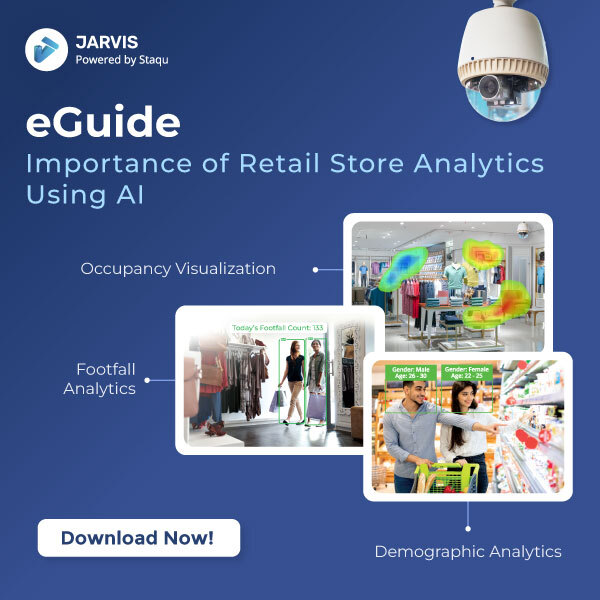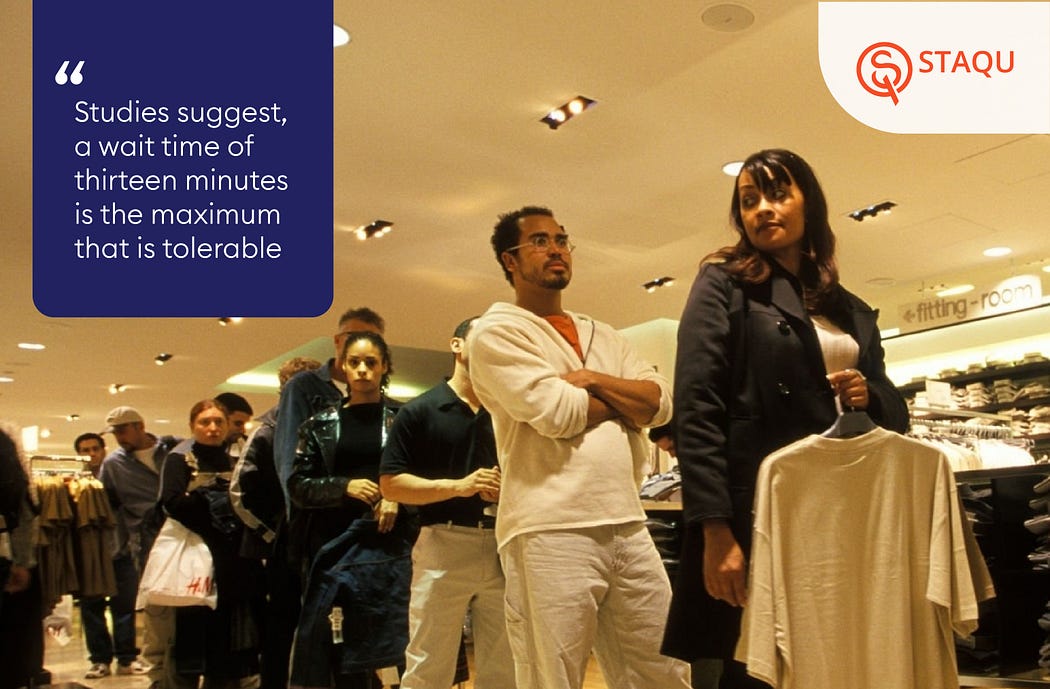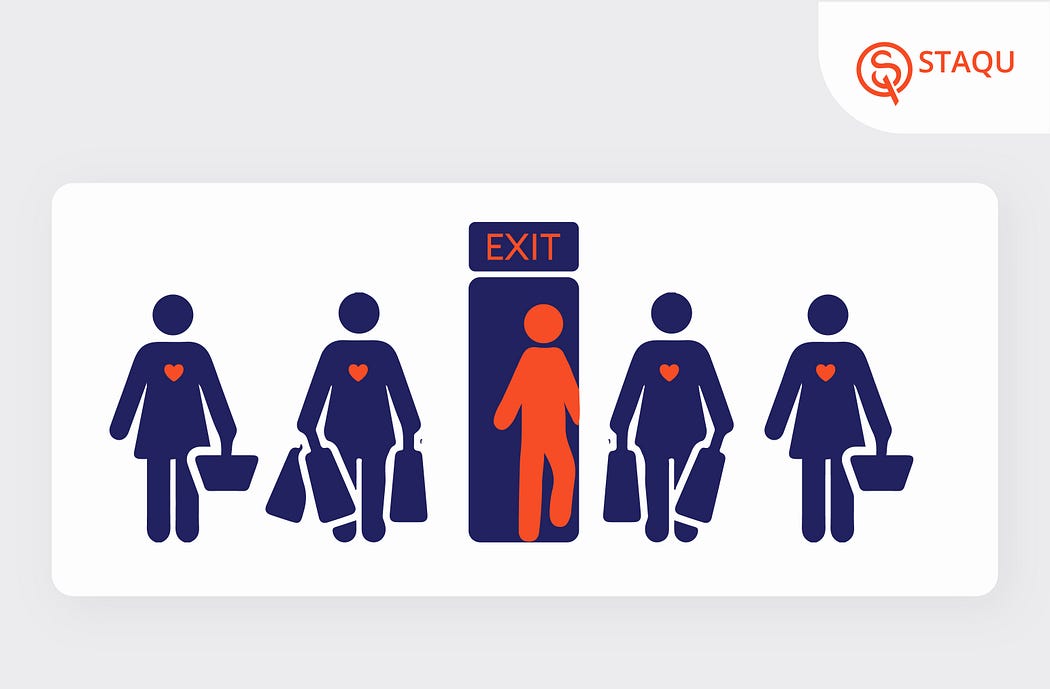5 Easy Steps to Elevate The Customer Experience at Your Retail Stores

We explore how retailers competing with e-commerce are addressing customer churns and preventing revenue loss with AI…
Imagine a scenario where a working couple celebrating their first wedding anniversary wants to go shopping at a retail store for gifts. They leave after office hours to shop for each other, tired and clueless about what to buy. After roaming the retail store, they finally decide to buy a few things. One partner is impatient, while the other can adjust accordingly. But guess what? There is an unbelievably long queue at the billing counter. They keep the gifts aside, go back home, and order stuff online.
Boom! There goes your potential customer who would have made your retail store’s experience a part of their first wedding anniversary celebration. And maybe more in the future.
In a time when big-box stores and retailers are ambushed by companies like Amazon and Flipkart, combating customer churn or attrition for brick-and-mortar stores has become more crucial. Customer churn is not a new occurrence for retailers, but in recent times, e-commerce behemoths that are known for attracting clients with jaw-dropping prices have made mapping the churn the most crucial metric.

The price game that e-commerce players initiated and have elevated could be the leading cause of churn. Another critical factor is that while retailers struggle to combine their data sources and incorporate ML models for improved execution, e-tailers have a solid tech base with AI and ML systems in place.
Also Read: A Comprehensive Guide On How Brick-&-Mortar Stores Can Compete With E-Commerce Platforms Using AI
The big question remains, how can retailers and large box stores combat churn in a hyper-agile market, especially during the holiday season when digital giants are working tirelessly to woo customers with great promotions?

Download eguide
The what and why of customer churn
We look at customer churn in retail, why it’s significant, and why it’s a crucial metric to measure.
According to an established marketing tenet, the key to generating deep customer engagement is to align customer journeys with customer data. Since apps are customers’ first point of contact, e-commerce players with deep tech chops have advanced analytics and machine learning algorithms to understand user behavior. This enables marketers to get relevant insights and turn first-time buyers into repeat customers, achieving their marketing objectives.
Contrary to e-tailers, retailers frequently monitor engagement rates, click-through rates, things in the cart, and unsubscribe rates, which are not valid indicators of customer attrition. Integrating intelligent analytics into your business is highly recommended by various studies to recognize accurate indicators.
Combatting customer churn through JARVIS

Customer churn helps forecast how future demographics will act. The wait time is a significant contributor to customer attrition. Waiting lines are usually long when queues are managed manually. According to studies, a wait time of thirteen minutes is the maximum that is tolerable; any longer than that will degrade the quality of the customer experience and cause tension to the retailer.
Customers will be less satisfied, and the churn rate will rise if they wait in poorly managed lines and interact with personnel already worn out from their tasks. The customer wait time and staff workload can be significantly decreased when an effective queue management system is utilized to manage the customer flow, which has a double impact on the customer experience and customer journey.

With Staqu’s video analytics solution, JARVIS, you can identify these metrics instantly. The JARVIS retail panel is instrumental in influencing operational decisions in a retail store by providing intricate cumulative details. For instance, it enhances the user experience by gathering data in a single platform. It not only showcases the primary data of your store but also enables decision-makers to access live aggregate data of all your stores and compare why and how some stores perform better than others through that data.
JARVIS acts as a bridge between the decision-makers and the customers. Embodying as an efficient queue management system, it can provide real-time queue dwelling time of customers, on which decision-makers can take necessary proactive actions to ensure customer turnover. When clients don’t have to wait too long, the customer turnover rate is lowered. The satisfied service and positive experience further improve the customer-company relationship and boost customer loyalty. Compared to regular consumers, devoted customers tend to endure more. Thus, it also aids in lowering the rate of client churn in the future.
The customer turnover rate is a sign of where a retailer is failing and where you need to increase your efforts before you lose a significant portion of sales to competitors. JARVIS also serves the purpose of being a means to planning staff management. With the dwell time data, store operators can assign staff to billing counters to fasten the billing process. Effectively measuring the churn rate requires combining data from several BI sources, JARVIS being a significant component.
Book A Free Demo

Retailers and online merchants are launching aggressive marketing campaigns to woo your wallet as the holiday season approaches. Reducing customer turnover in this situation involves ensuring recurring business and attracting high-value clients who expand your clientele. Everything begins with the trendy term “omnichannel retailing,” which means “knowing the customer, what he or she wants, and recouping the money spent on marketing.”
Brick-and-mortar stores will need to rekindle consumer enthusiasm, according to industry analysts, for retail businesses to regain their competitive advantage.
Predictive analytics can assist in preventing churn in this situation.
As a retailer, you might be thinking, why utilize JARVIS for something that an employee can do? You can use your employee to identify queue-related problems, but the differentiating feature of JARVIS is that it helps you recognize the trends of your retail business. Along with showing the average waiting time, JARVIS shows the queue waiting time for different genders on each day across all weeks of a selected year. It will justify trends with factual data. For example, take the case of a men’s apparel store where you can buy formal wear clothing, fabrics, and similar items. You can identify when women visit your men’s apparel store the most and on which days they are willing to wait in your queues, irrespective of it being a long queue. Accordingly, with the data, decision-makers can be prepared with staff planning, store management plans, and other operational processes in advance to avoid churn.

- One can gain a sense of consumer behavior by examining historical data from JARVIS.
- To generate a score for probable churners, all the siloed data must be merged together. JARVIS accurately does this through its video management system.
- The score algorithms that analysts develop can determine the churn probability. In this case, JARVIS’s high accuracy rate is instrumental in predicting business decisions.
- The predictive data to avoid churn determines the marketing approach, which separates high-value and low-value consumers to decide whether to focus on loyal customers or retain churners.
- Predictive churn management model insights can be used as significant inputs for the BI strategy.
Final Thoughts
To lower customer churn, boost customer retention, hasten customer acquisition, and turn one-time customers into repeat customers, brick-and-mortar stores will have to employ predictive analytics. The difference between offline and online sales is still very wide for established retail brands. Businesses may efficiently implement their rules and strategies with a well-versed queue management system, such as JARVIS, which also streamlines the customer flow through the various stages of the customer journey, keeping consumers active and lowering the customer turnover rate.